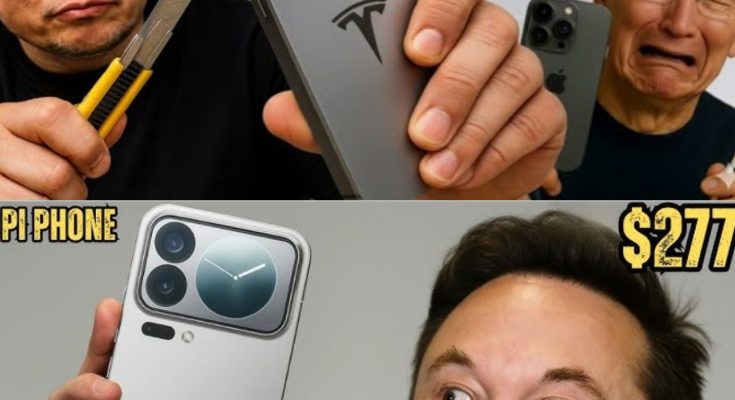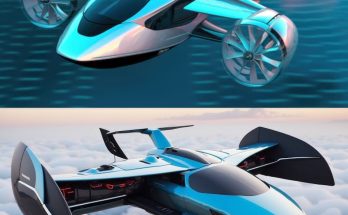It’s finally happening. After years of rumors, speculation, and wild fan theories, Elon Musk’s $277 Tesla Pi Phone is officially hitting the market — and tech insiders are already calling it the biggest disruption to the smartphone industry since the very first iPhone.
Dubbed “the phone that could end Apple,” Musk’s latest creation combines Tesla’s futuristic design language with Starlink’s ultra-fast satellite internet, and a suite of innovations that feel like something straight out of a sci-fi film.
At $277, the Tesla Pi isn’t just affordable — it’s audaciously priced to destroy the competition. But the real shocker isn’t the price. It’s what’s inside.

A Phone That Redefines Everything
At first glance, the Tesla Pi looks sleek but familiar — until the screen lights up. The device features a solar-reactive nano-glass display that adjusts its brightness and color temperature automatically based on the surrounding environment. Unlike any smartphone before it, the Pi’s body is made from liquid titanium alloy, giving it the durability of aerospace metal with the weight of glass.
Juegos familiares
Inside, the phone houses the new Tesla Neural Engine (TNE-1) — a custom AI chip built to handle massive data processing with near-zero lag. This chip isn’t just fast; it learns your behavior. From how you scroll, to the way you type, it anticipates actions before you make them, making every interaction seamless.
One of the most jaw-dropping features? Full Starlink integration. That means the Tesla Pi doesn’t need traditional cell towers. It connects directly to Musk’s Starlink satellite network, providing global high-speed internet even in remote deserts or on top of mountains. Imagine making a FaceTime-quality call from the middle of the Sahara — no Wi-Fi, no SIM card, no problem.
$277: Genius or Madness?
At a time when flagship smartphones routinely cost $1,000 or more, the Tesla Pi’s $277 price tag sounds almost too good to be true. Industry analysts are already calling it a “strategic nuclear strike” on Apple and Samsung’s pricing models.
“Elon’s playing a completely different game,” said tech analyst Avery Lee from TechRadar. “He’s not trying to compete in the smartphone market — he’s trying to redefine it. The Pi is priced to make you question why an iPhone costs $1,200.”
The affordability stems from Musk’s philosophy of vertical integration — every component, from chips to software to internet connectivity, comes from Tesla or SpaceX. There are no middlemen, no carrier partnerships, and no licensing fees. Musk has effectively created a self-sustaining tech ecosystem that can operate outside the traditional telecom infrastructure.
And that’s what’s terrifying the giants in Cupertino.
Apple in Panic Mode?
Just hours after the Tesla Pi announcement, leaks from within Apple’s headquarters in Cupertino reportedly showed an emergency meeting led by CEO Tim Cook. Internal memos described the Tesla Pi as a “clear and immediate threat” to Apple’s future market share.
Apple’s biggest concern isn’t just the specs — it’s the philosophy.
“The Tesla Pi breaks the model we’ve depended on for over a decade,” said one former Apple executive speaking anonymously. “No carrier contracts, no cloud subscriptions, no upgrade pressure. It’s pure freedom — and that’s the one thing Apple can’t sell.”
Social media has already turned the story into a frenzy. On X (formerly Twitter), hashtags like #GoodbyeApple and #TeslaPhoneRevolution have gone viral, with users posting memes of Musk “burying” Apple under a Tesla logo. Even YouTubers known for their Apple loyalty are jumping ship, calling the Pi Phone “the first real threat to iPhone supremacy.”

Features Straight Out of the Future
So what exactly makes the Tesla Pi so “insane inside”? Here’s a closer look at its most talked-about features:
- Starlink Connectivity:
Say goodbye to dropped calls. Whether you’re in downtown Manhattan or hiking in the Himalayas, you’ll have stable, high-speed internet. - Solar Charging Panel:
The back of the phone features an integrated solar film layer that can fully charge the device in just two hours of direct sunlight. - AI-Powered Interface (NeuraOS):
The Tesla Pi runs on NeuraOS — an AI-driven system that literally evolves with you. It learns your routines, predicts your needs, and automates daily tasks with eerie accuracy. - Brainwave Control Mode:
Yes, you read that right. Using Tesla’s Neuralink-compatible technology, users can control certain phone functions — like answering calls or scrolling — through minimal neural signals. It’s optional, but it’s there, and it’s very real. - Battery Life That Won’t Quit:
Thanks to Tesla’s graphene-based power cell, the Pi Phone can run up to 96 hours on a single charge, or two full days of heavy use. - Camera of the Future:
A 108MP ultra-lens with night vision capability, 16K video capture, and an adaptive sensor that adjusts to lighting faster than the human eye.
Inside the “Tesla Ecosystem”
The Pi Phone isn’t meant to stand alone. It’s the first building block of what Musk calls the “Tesla Digital Ecosystem” — a world where your phone, car, home, and even your internet connection all sync seamlessly.
Own a Tesla car? The Pi automatically connects, unlocking the vehicle, syncing your preferences, and even letting you drive using a “Virtual Key Mode.”
Using Starlink at home? Your Pi serves as a portable router, boosting your connection wherever you go.
Need to pay? It integrates directly with X Payments, Musk’s new digital currency platform, allowing instant crypto and fiat transactions without fees.
Every feature points to a single goal: total independence from existing tech monopolies.
Public Reaction: Hype Meets Hysteria
Within minutes of the official reveal, Tesla’s website reportedly crashed under overwhelming demand. Preorders sold out in 12 minutes flat, and resellers have already begun listing early units on eBay for more than $1,500.
Meanwhile, critics have raised questions about privacy, neural integration, and the ethical implications of AI-driven user profiling. But for Musk fans, it’s all part of the excitement.
“Elon is giving us the future Apple promised but never delivered,” one commenter wrote on Reddit. “They gave us better cameras — he’s giving us better freedom.”
Is This the End of Apple?
While it’s too early to write Apple’s obituary, there’s no denying that the Tesla Pi marks a historic turning point. For the first time in over a decade, a challenger has emerged that isn’t just competing on design or performance — but on philosophy.
Where Apple built a walled garden, Musk is building a digital frontier. Where others charge more for incremental upgrades, Tesla’s betting on accessibility and innovation at a fraction of the cost.
“This is what disruption looks like,” said analyst Sarah Cline of Wired. “It’s not about specs. It’s about breaking systems. And Elon Musk has made a career out of breaking systems.”

The Dawn of a New Tech Era
If the Tesla Pi delivers even half of what Musk has promised, it could reshape the tech world forever. It’s not just a smartphone — it’s a declaration of independence from everything we thought we knew about technology.
At $277, the Tesla Pi isn’t just a bargain. It’s a warning shot across the entire industry.
As Musk himself posted hours after the reveal:
“Innovation isn’t about improving the system. It’s about replacing it.”
For Apple, that might be the most terrifying message of all.
And for everyone else? It’s the beginning of the future — in the palm of your hand.



